“Brands I Prefer: Everything Else”
As I’ve mentioned before, I love working with these old Love molds, but the legs on these guys can be atrocious. Without digging up a china copy to compare, it’s hard to tell how much of their turned out legs are part of the original sculpture, the outcome of imperfect casting, or the result of abuse received after leaving the factory.
Does it matter what caused the leg to turn out? Yes and no. My basic process is always the same. However, if I know the turned out leg was established in the mold, the more resculpting work I can anticipate. If the turned leg was sculpted into the mold, when I turn the leg back it will create a slight corkscrew shape, which I'll have to fix later. However, if it's a warped leg that happened after sculpting (most likely an exposure to pressure or heat,) then the leg may require no resculpting when bent back.
This is good news for the collectors reading this post who are thinking of fixing your wobbly OFs with this technique. However, the bad news is I don't recommend this exact technique for OFs because there is a very high chance of damaging the surface or finish of a model this way. That's fine for a custom whose finish I intend to destroy in the first place. But for OFs, I suggest you think twice before using a heat gun to fix their legs unless you have a lot of experience with your heat gun. Specifically, you need to know how long you can expose a Breyer without burning or boiling the plastic. The only way to learn how long is too long, in my opinion, is to burn a few Breyers...so I don't suggest trying this out on a model you care about.
For OFs, I highly recommend using a hair dryer. Avoid submerging them in boiling water as well as some types of finish can be ruined this way. Boiling water is for noodles, not for ponies.
Bad Posture or Bad Conformation?
My horse drives me nuts because she has great legs, but seems to go out of her way to hide that fact.
Old photo--for the record. My God was she fat.
Horses are bendy. They can turn their legs inward and out just for sh!ts and giggles. This flexibility is ultimately a good thing as it allows them to make cool moves like this...
...but it also makes getting great conformation shots of a standing and largely disinterested horse a giant pain in the ass. When you see perfectly stacked halter horse in the show ring, remember that this is a “move” which takes a numerous hours to train a horse to do. For that matter, I’ve seen champion halter horses who toe out, yet they win conformation competitions because they are trained to straighten up for the judge. I already felt halter classes were BS in the first place; this pretty much clinched it.
Yuck.
So if horses with straight legs can stand in weird positions and horses with weird legs can stand up straight, how do we judge legs on model horses? Do we ignore bad legs? Do we discount flaws? How can we be sure the sculptor didn’t just catch a great horse in an unflattering pose?
We can’t be sure, but we can’t ignore bad legs. Like many, many other elements of the hobby, it’s a conceit in the show ring that mechanical twists portrayed on a model are assumed to be inherent flaws. What you see is what you get. A twisted leg is always considered a flaw, so it's something a custom artist should address when starting a new project.
So Just Heat It Up & Move, Right?
I try to take a slightly more nuanced approach to bent legs. Ideally, I'd like to fix the leg just by bending it back. If I don't have to carve or fill any part the leg, that could save as much as two or three hours of work for me. Those hours include sanding, filling, prodding, sculpting, sanding, carving prepping, and patching all of which sounds very unfun. So I take a little extra time "gaming planning" where I heat and move the leg to save myself a lot of work in the long run.
Casanova's front legs were a challenge. He had one (mostly) good leg and one very bad leg:
His bad leg--his right leg--wasn't just bent or turned out. It was curve. The problem areas were also a touch counterintuitive when you consider equine anatomy. The biggest areas of bend weren't at any of this joints. They were in the cannon bone and in the forearm, just above the knee. This is what I would consider an anatomical flaw as opposed to a conformation flaw. Real horses can toe out. It's not pretty, but it's something they can live with. However, the bones of the leg cannot and should not bend.
So this was where I planned to heat:
When working more than one move on a leg, I start with the top most area and work my way down. For this mold, I wanted to align the top of the forearm with the knee before even looking at the rest of the leg. If I'm considering the rest of the leg, it can be too tempting to over bend an area to just to reach my final goal. In that case, the top of the leg and the hoof might line up straight, but I'll be left with twists and turns in between.
My heat gun technique here is to pass the gun over the area for 30 seconds (remember to heat the back and inside of the leg, too.) After 30 seconds, I stop and test the leg's resistance. If it's not ready to move, I heat for an additional ten seconds and test again, repeating this process until the leg moves with some resistance. I want to have to push it, but not shove it violently. If I have to push too hard, I'm just as likely to break the leg as to bend it.
When I'm happy with the upper leg, I dip it in ice water to set, then I move on to the cannon bone. This time, I'll heat the plastic for maybe only 15 to 20 seconds before testing it's resistance. The thinner plastic on the lower portions of a leg will melt much quicker than you'll expect. In short, it's easier to screw up here. Again, I look at just the area I'm working on and not the whole leg.
In an ideal world, when I straighten both areas individually, the whole leg will end up perfectly aligned. But I rarely--if ever--find myself in that sort of situation.
After getting the leg straight by itself, I discovered it was also hanging out on the edge of the body. This was no longer a simple heat and bend. To fix it, I heated up the area around the top of the leg and smooshed it slightly inward.
I had to finish the whole operation with a minor amount of resculpting through the shoulder and between his legs. Also, notice the bottom of his hooves are no longer flat. I had to fix that too, but that's a topic for a different post.

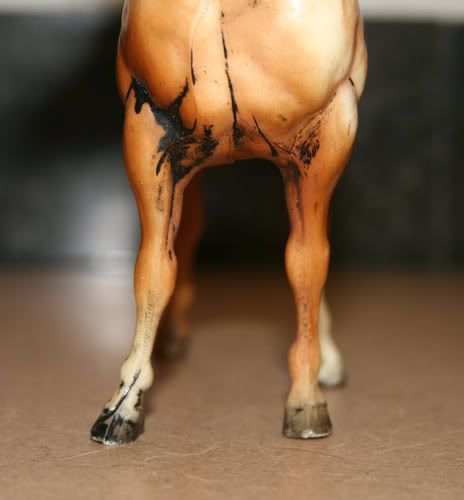

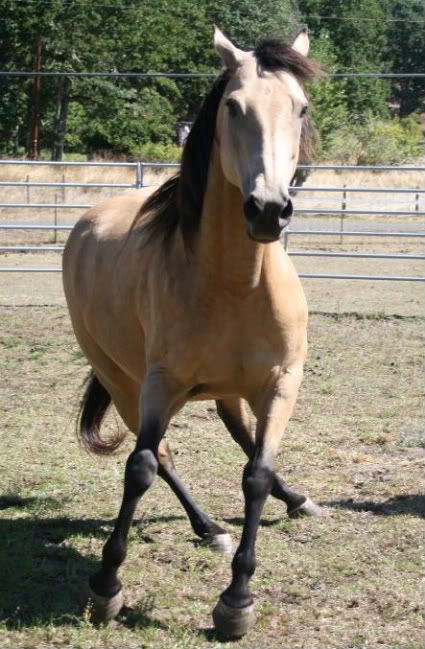

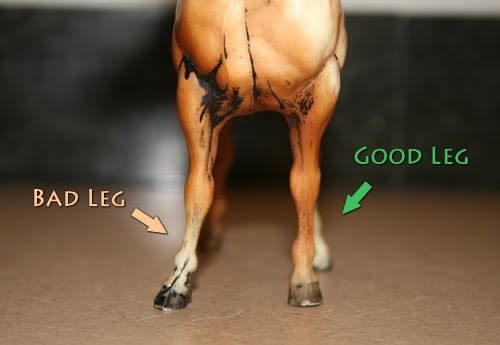
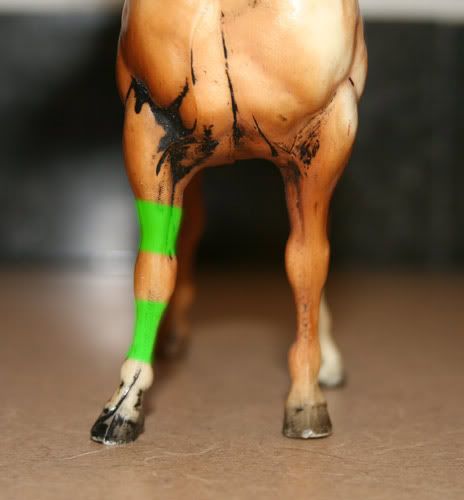
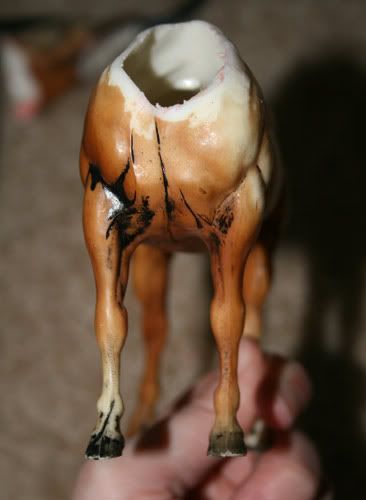

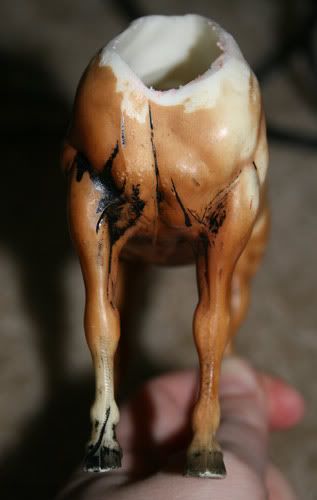




1 comment:
I have several critters who are as wobbly as drunken sailors. Thanks so much for posting this!
Post a Comment